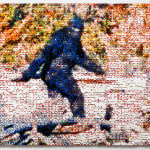Claire Healy & Sean Cordeiro
Patty 352, 2023
recontexualised lego on board
156 x 208 x 3 cm
Artwork reference: Frame 352 of the 1967 Patterson–Gimlin film, alleged by the filmmakers to depict a female Bigfoot. Bigfoot, also commonly referred to as Sasquatch, is a large and hairy...
Artwork reference:
Frame 352 of the 1967 Patterson–Gimlin film, alleged by the filmmakers to depict a female Bigfoot.
Bigfoot, also commonly referred to as Sasquatch, is a large and hairy human-like mythical creature alleged by some to inhabit forests in North America, particularly in the Pacific Northwest. Bigfoot is featured in both American and Canadian folklore, and since the mid-20th century has grown into a cultural icon, permeating popular culture and becoming the subject of its own distinct subculture.
Enthusiasts of Bigfoot, such as those within the pseudoscience of cryptozoology, have offered various forms of dubious evidence to prove Bigfoot's existence, including anecdotal claims of sightings as well as alleged photographs, video and audio recordings, hair samples, and casts of large footprints. However, the scientific consensus is that Bigfoot, and alleged evidence, is a combination of folklore, misidentification, and hoax rather than a living animal.
Folklorists trace the phenomenon of Bigfoot to a combination of factors and sources, including the European wild man figure, folk tales, and indigenous cultures. Examples of similar folk tales of wild, hair-covered humanoids exist throughout the world, such as the Skunk ape of the southeastern United States, the Almas, Yeren, and Yeti in Asia, the Australian Yowie, and creatures in the mythologies of indigenous people.
Wishful thinking, a cultural increase in environmental concerns, and overall societal awareness of the subject have been cited as additional factors.
Frame 352 of the 1967 Patterson–Gimlin film, alleged by the filmmakers to depict a female Bigfoot.
Bigfoot, also commonly referred to as Sasquatch, is a large and hairy human-like mythical creature alleged by some to inhabit forests in North America, particularly in the Pacific Northwest. Bigfoot is featured in both American and Canadian folklore, and since the mid-20th century has grown into a cultural icon, permeating popular culture and becoming the subject of its own distinct subculture.
Enthusiasts of Bigfoot, such as those within the pseudoscience of cryptozoology, have offered various forms of dubious evidence to prove Bigfoot's existence, including anecdotal claims of sightings as well as alleged photographs, video and audio recordings, hair samples, and casts of large footprints. However, the scientific consensus is that Bigfoot, and alleged evidence, is a combination of folklore, misidentification, and hoax rather than a living animal.
Folklorists trace the phenomenon of Bigfoot to a combination of factors and sources, including the European wild man figure, folk tales, and indigenous cultures. Examples of similar folk tales of wild, hair-covered humanoids exist throughout the world, such as the Skunk ape of the southeastern United States, the Almas, Yeren, and Yeti in Asia, the Australian Yowie, and creatures in the mythologies of indigenous people.
Wishful thinking, a cultural increase in environmental concerns, and overall societal awareness of the subject have been cited as additional factors.
Art, events and ideas in your inbox.
We won't send you lots of emails. Promise.
* denotes required fields
We will process the personal data you have supplied in accordance with our privacy policy (available on request). You can unsubscribe or change your preferences at any time by clicking the link in our emails.



